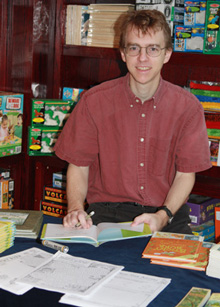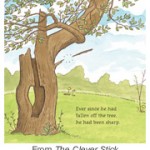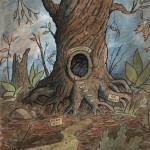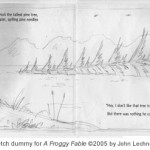
Say a big hello to John Lechner. He is the author and illustrator of four books for children, A Froggy Fable, Sticky Burr: Adventures in Burwood Forest, The Clever Stick and Sticky Burr: The Prickly Peril, all published by Candlewick Press. Thank you for joining us today.
When did you get started illustrating for children? What did you do before?
My first book, A Froggy Fable, was published in 2005, but I have been writing and drawing my whole life. Before being published, I worked as a graphic designer, puppeteer, animator, interactive designer and art director.
Tell us a little bit about the recent books you wrote and illustrated, The Clever Stick and Sticky Burr: The Prickly Peril.
The Clever Stick is a fable about a stick who is sad because he cannot speak. He has many thoughts he wants to share, but doesn’t know how. In the course of the book, he discovers his “voice”. My other recent book, Sticky Burr: The Prickly Peril, is about a group of burrs who live in the forest, and what happens when their village is attacked by the wicked Burweena and her spiders. It’s part comic book, part storybook, part nature journal.
What are you working on right now? Do you have any other books or art projects you’d like to talk about?
Right now I’m working on a novel, which is very different from my other books. I also launched a blog last fall called The Untended Garden, where I highlight artists and writers inspired by nature. I think it’s ironic that even though we know more about nature than ever before, we are becoming more and more isolated from it. Art and literature have always helped us see our world in new ways, and I hope to bring that sense of discovery and exploration to today’s readers.
You work in animation and interactive storytelling. What project are you currently involved in? How do these disciplines differ from picture book illustration?
Lately I’ve been very interested in interactive storytelling, combining the elements of an illustrated book and an animated film into something new. I’ve been working on my own interactive story for over a year now, which I hope to launch this spring.
I love animation because it’s a unique kind of visual storytelling, and combines many different art forms. It is a lot like book illustration, except you multiply the number of illustrations exponentially, and look at them REALLY fast. You are still telling a visual story, but showing every action and scene, leaving less to the viewer’s imagination. In this way, it is a less intimate experience than reading a book, since much of a book’s reality takes place inside the reader’s imagination. But you can also add things to animation like music and sound effects, which can enhance your story in ways that a book can only dream of.
Do you do non-children’s book art (licensing, fine art, etc.) or art just for fun? Is that art similar or different from your children’s book art?
Besides book illustration, I love to draw and paint for fun. I like painting with watercolors outdoors, though I don’t have much time for it. You can see a lot of my miscellaneous work on my website gallery http://www.johnlechner.com/gallery/index.html. It’s not too different from my children’s book art, but a bit more eclectic.

Do you illustrate full time? If not, what else do you do?
I work full-time as an Art Director at the children’s media company FableVision. There I do everything from animation to web design. One of my recent projects was designing a new website for Mister Rogers’ Neighborhood which was very exciting and humbling to work on. My latest project is co-directing the animated film The North Star, based on the book by Peter H. Reynolds, which will be released later this year.
When you illustrate a picture book how do you decide what scenes and details to draw?

I usually visualize the story in my head, and draw what I see. There is no system or structure to my sketching, I just try out different views and angles until I have something that flows together. I try to give each scene some visual drama, even if it’s just a field of flowers. And it’s important for the drawings to work together as a sequence, both visually and dramatically. You can’t just focus on each page as a self-contained picture, you always have to think of how it fits into the book. That’s what separates great picture books from ordinary ones, when the pictures flow together so seamlessly that you don’t even notice you’ve turned the page. That’s something I’m still striving for.
When illustrating picture books do you include a visual storyline not mentioned by the text or include animals or people you know?
I draw many things that aren’t in the text, such as recurring background characters, or changes in color or composition to reflect the mood. Since most of my stories are about animals or insects, I don’t usually include people that I know (at least, not consciously!)
Can you explain your art process?
After I have the final sketch dummy (which is the result of many revisions with pencil and paper), I will sketch out the final illustrations on watercolor paper, actual size. I prefer actual size because I like to work small, and it also shows me exactly what the final page will look like. After sketching, I will draw the final lines using black India ink and a fine brush. Then I will erase the pencil lines, and paint the illustration with watercolor. I usually work on several paintings at a time, since the watercolor has to dry after each section so it doesn’t run. I will often do the whole illustration over, if it doesn’t turn out the way I want. I think the entire book A Froggy Fable was illustrated twice, because I wasn’t satisfied with my first attempts.
Do you have a favorite color or palette?
Most of my stories take place outdoors, and I love greens and browns, especially yellow ochre.
What is your favorite medium to work in? Have you always worked in this media? If not, why did you switch?
I prefer watercolor and ink, which I have used for all my books. I’ve tried other mediums over the years, but watercolors seem to best express the ideas and feelings that I’m trying to convey.


Did you always want to be an artist when you grew up?
Yes, along with a musician, puppeteer, writer, filmmaker, and many other things.
Do you use models/source pictures or do you draw from your memory/imagination?
I mostly draw from my imagination, though I often model my scenery on real places. For instance, the tree at the beginning of The Clever Stick is an old apple tree from my backyard. And for the Sticky Burr books, I research all the animals and insects that I draw, then simplify them to make them fit the style of the story.
If you could be anything other than an artist, what would you be?
If I weren’t making books, I would love to be a musician and composer. I play the violin, guitar and ukulele, and I actually wrote the songs in the back of my Sticky Burr books.
What gets you through an illustration when you’re stuck for inspiration?
Deadlines.
What book do you remember from when you were young? (list one or multiple books)
I had many favorite books as a child, including everything by Richard Scarry, Bill Peet and Dr. Seuss. I liked books with lots of visual details, but also a good story.
Is there a children’s book illustrator whose work you gravitate towards in the bookstore now?
I’m always drawn to illustrators whose work is very different than my own, particularly those with a bold sense of texture and design like Lane Smith or Melissa Sweet. I love artists who can create a unique world that the reader can get lost in.
If you could illustrate any writer’s new work, who would it be?
Lately I have been very inspired by Diana Wynne Jones. Her writing is so rich, so imaginative, it would be an honor to illustrate even a single sentence of hers.
Who do you want to be when you ‘grow up’?
I don’t plan to. In fact, I think I might start growing younger instead of older, and spend more time making things, jumping in puddles, and exploring the world around me.




 RSS - Posts
RSS - Posts
John, thanks for sharing your time with us today!